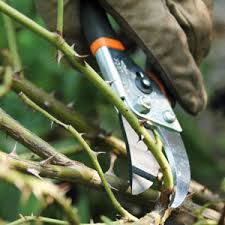Prune Your Heart Out!!
Winter is a prime time to prune your trees and shrubs. The leaves are long gone and most woody plants are dormant, making it an ideal time to give them a trim. Well-pruned plants produce more flowers and fruit. And sensible pruning helps trees and shrubs ward off pests and diseases, so you'll have to care for them less.Pruning in winter, invigorates many trees and shrubs because it leaves the plants with extra root and energy reserves that will support new growth on the remaining branches. Dormant-season pruning is good for you, too, because you can see the branches more clearly without leaves in the way. And it gives you a reason to go outside on mild winter days.
 PRUNING HOW TO:
PRUNING HOW TO:
Remove dead or dying branches.
Prune out diseased limbs right away. Be sure to cut well below the diseased areas, and don't prune when the plants are wet (water can spread disease). If you prefer to be extra cautious, rinse your tools with a solution of 10 percent bleach in water.
Cut back branches that have grown over where you walk or mow so they don't break off.
Where you see two branches crossing, prune off the smaller one.
Thin branches judiciously to allow sunlight and air into the center of trees and shrubs.
Prune branches at the node, this is where one branch and twig attach to each other.
Pruning Dos and Don'ts
DO cut at an angle that mirrors the branch collar—the furrow of bark where branch and trunk meet. Cut the branch next to the branch collar. If you did it right, a circle of healthy callus will swell around the spot.
DON'T scalp your trees. A tree with a flat-top looks ridiculous, and it will grow weak new sprouts in place of healthy branches. Cut to the tree's natural shape and let it grow up. Pruning is a vital part of gardening. The key is to know why we're sharpening our shears. Consider these three reasons:
To Thin:
Remove to improve. Thinning is about cutting out all dead, diseased, and injured parts to let in more air and light. Most important, thinning prevents confusion of a plant's structural line and enhances it health.
To Reduce:
In Nature, most plants we grow are in splendid isolation, trying to spread unnaturally fast. Our job is to prevent certain shrubs and trees from outgrowing their position in a yard. Judicious reducing helps plants develop into sound structures without over-stressing their limbs. Also, maximum flowering and bountiful fruit are only possible by pruning.
To Amputate:
It sounds harsh, but severe pruning is necessary to restore older trees and shrubs to better health. Most plants are amazingly forgiving with experimentation. Think twice, cut once, and watch carefully. Your plants will tell you in their own way how to do better next season. This photo shows an example of a correct cut on a rose bush.. practice makes perfect in the world of pruning..
This photo shows an example of a correct cut on a rose bush.. practice makes perfect in the world of pruning..
| Example of how to trim your trees and bushes! |
Remove dead or dying branches.
Pruning Dos and Don'ts
DO cut at an angle that mirrors the branch collar—the furrow of bark where branch and trunk meet. Cut the branch next to the branch collar. If you did it right, a circle of healthy callus will swell around the spot.
DON'T scalp your trees. A tree with a flat-top looks ridiculous, and it will grow weak new sprouts in place of healthy branches. Cut to the tree's natural shape and let it grow up. Pruning is a vital part of gardening. The key is to know why we're sharpening our shears. Consider these three reasons:
To Thin:
Remove to improve. Thinning is about cutting out all dead, diseased, and injured parts to let in more air and light. Most important, thinning prevents confusion of a plant's structural line and enhances it health.
To Reduce:
In Nature, most plants we grow are in splendid isolation, trying to spread unnaturally fast. Our job is to prevent certain shrubs and trees from outgrowing their position in a yard. Judicious reducing helps plants develop into sound structures without over-stressing their limbs. Also, maximum flowering and bountiful fruit are only possible by pruning.
To Amputate:
It sounds harsh, but severe pruning is necessary to restore older trees and shrubs to better health. Most plants are amazingly forgiving with experimentation. Think twice, cut once, and watch carefully. Your plants will tell you in their own way how to do better next season.
Comments
Post a Comment